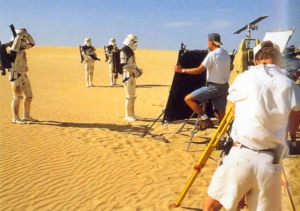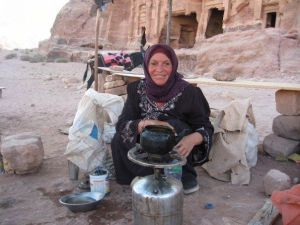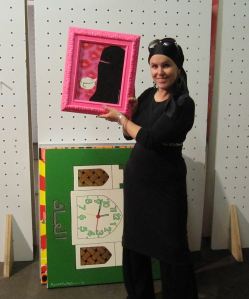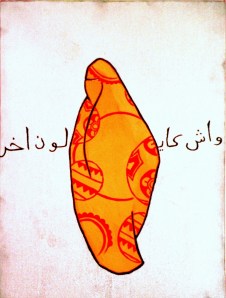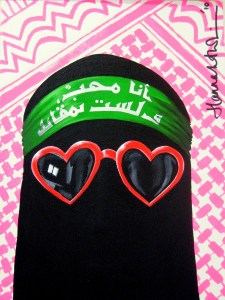Some argue that ‘Middle Eastern stereotypes’ in the Star Wars films present a racist point of view. Faiz Sheikh, an avid member of the ‘fandom’, sets the record straight.
So yes in the final scene on Star Wars Episode 4 you can look and look and not find one ethnic minority in the hundred or so soldiers parading to celebrate the destruction of the Death Star. I thought I found one once, but it turns out the guy had a beard and his helmet was casting a shadow on his face, the hands gave him away. Therefore George Lucas is a racist, right? Well no if you take into account Lando Calrissian in episodes 5 and 6. In fact all you casual fans out there might be interested to note the various Middle Eastern inspired characters in Star Wars. If you are of the hardcore ‘fandom’ then I will not presume to be able to teach you anything here.
The Deserts of Tunisia
In the desert scenes in Episode 4, which probably constitute a good quarter of the film, we meet our young point of view character Luke Skywalker, his mysterious and wise mentor Obi Wan and everyone’s favourite scoundrel Han Solo on the desert planet, Tatooine. These scenes were in fact filmed on location, in Tunisia. George Lucas, the writer and director of Episode 4, was clearly inspired by the clothing worn by native Tunisians. The Jedi, robed mystic figures, wear the challaba, or thobe commonly seen in North Africa. During the time that I was living in Morocco I for one could not resist buying a cream challaba with a brown ‘cape’ (warmer, winter over wear) an ‘instant Jedi outfit’ which, actually, might be quite commonly seen at Friday prayers.
However, the comparison with the noble Jedi is not all. Another robe wearing desert dweller in Episode 4 is the Jawa. There are a multitude of these little guys who carve out an existence scavenging and selling scraps. They are a nuisance, vexing the film’s protagonists and shown to drive a very hard bargain. I wonder if Lucas visited the Tunisian markets before filming?
Whether we can accuse Star Wars of racial insensitivity is, I believe, a hard question to answer, and that difficulty is compounded when we turn to the infamous Jabba the Hutt of Episode 6: Return of the Jedi.
The Deserts of… Arizona?
While the fictional location of the opening scenes on Episode 6 is the same desert planet of Tatooine seen in Episode 4, the filming took place this time in Arizona. However the character of Jabba, arguably, represents another Arab stereotype: the rotund Sheikh of the Arabian Peninsula. Jabba is quite a grotesque, large, round slug type creature. He is arrogant and commanding, residing inside a palace where everything and everyone serves at his pleasure. He is also an intergalactic criminal. There are two things that I feel people have picked up on in calling Jabba a fat Sheikh: He is definitely smoking a sheesha pipe when we first meet him and he exists in a context that, as I described earlier, is aesthetically likened to the Arab world. Well the context argument can’t hold water as there are deserts all over the world. The fact he is smoking a sheesha is much harder to dismiss, but so what!
Pulp fiction vs. Literary classic
Frank Herbet’s Dune series unabashedly borrows from Arab and Islamic references. The main protagonist in Dune referred to as the Mahdi (12th, hidden Shi’ia Imam), the book references the azan (call to prayer) of the native people, the bahr (sea) of sand and my edition even misspells the fictional Emperor Shaddam as ‘Saddam’. But, this book is a great novel of critical acclaim, few would dare call it racial stereotyping.
So is Star Wars racially insensitive? I think not. Were it a high brow piece of art or literature, like Herbert’s Dune then I doubt many people would complain. As it is, Star Wars is pulp fiction, glorious, but pulp fiction non-the-less. As such, it condenses characters into simple, entertaining screen shots. Is the appearance of the Jedi order, a mystical, robe wearing group of old men, inspired by the not so mystical old men of Tunisa? Probably. The same is also true of the not so flattering inspiration for the hardnosed Jawas. But then again none of the characters have any more depth to them than that, except perhaps Darth Vader. Luke is a poor farm boy who has adventure thrust upon him and seeks a greater destiny. Leia is a princess who, while being ‘badass’ in her own right, also functions as the archetypal damsel-in-distress. Han is a cocky rouge with a heart of gold and Chewie his loyal steed. The entire Star Wars series is a re-telling of a tired old fantasy clichés: wizards, an evil empire, bandits, princesses and farm boys. That it is clichéd in its portrayal of secondary characters is no surprise given the main characters do not fair any better; just sit back and enjoy the saga.
BY Faiz Shiekh

